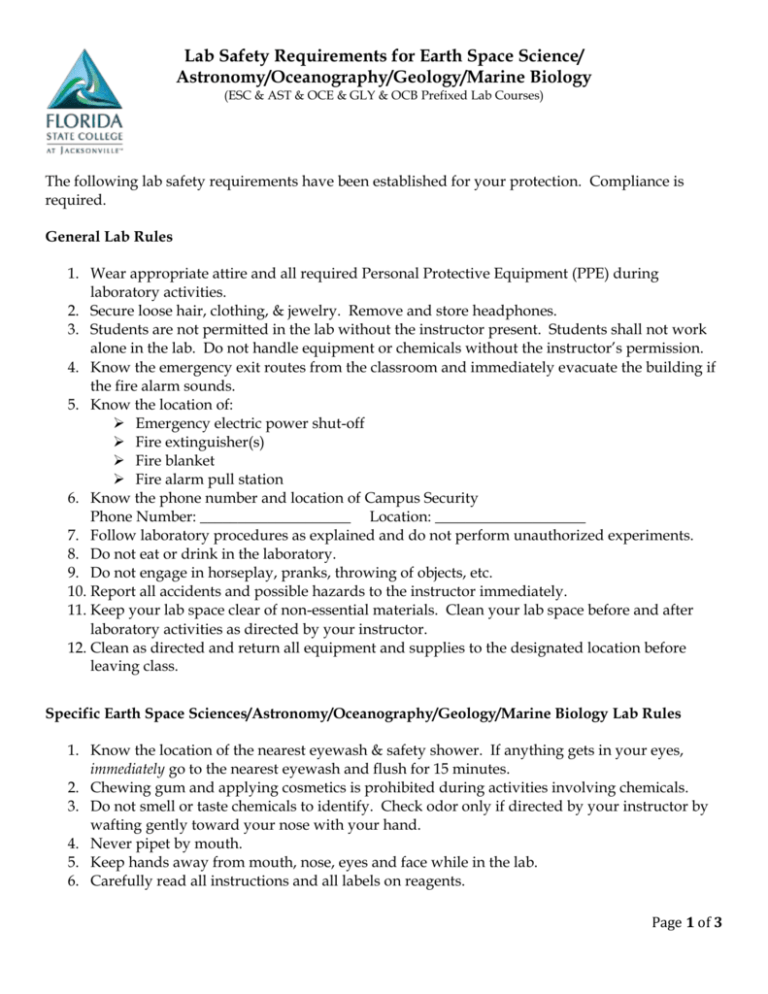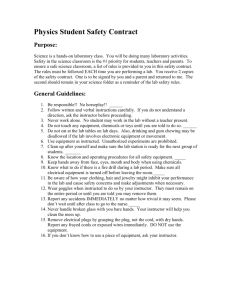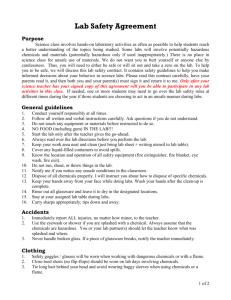Lab Safety
advertisement

Lab Safety Requirements for Earth Space Science/ Astronomy/Oceanography/Geology/Marine Biology (ESC & AST & OCE & GLY & OCB Prefixed Lab Courses) The following lab safety requirements have been established for your protection. Compliance is required. General Lab Rules 1. Wear appropriate attire and all required Personal Protective Equipment (PPE) during laboratory activities. 2. Secure loose hair, clothing, & jewelry. Remove and store headphones. 3. Students are not permitted in the lab without the instructor present. Students shall not work alone in the lab. Do not handle equipment or chemicals without the instructor’s permission. 4. Know the emergency exit routes from the classroom and immediately evacuate the building if the fire alarm sounds. 5. Know the location of: Emergency electric power shut-off Fire extinguisher(s) Fire blanket Fire alarm pull station 6. Know the phone number and location of Campus Security Phone Number: ____________________ Location: ____________________ 7. Follow laboratory procedures as explained and do not perform unauthorized experiments. 8. Do not eat or drink in the laboratory. 9. Do not engage in horseplay, pranks, throwing of objects, etc. 10. Report all accidents and possible hazards to the instructor immediately. 11. Keep your lab space clear of non-essential materials. Clean your lab space before and after laboratory activities as directed by your instructor. 12. Clean as directed and return all equipment and supplies to the designated location before leaving class. Specific Earth Space Sciences/Astronomy/Oceanography/Geology/Marine Biology Lab Rules 1. Know the location of the nearest eyewash & safety shower. If anything gets in your eyes, immediately go to the nearest eyewash and flush for 15 minutes. 2. Chewing gum and applying cosmetics is prohibited during activities involving chemicals. 3. Do not smell or taste chemicals to identify. Check odor only if directed by your instructor by wafting gently toward your nose with your hand. 4. Never pipet by mouth. 5. Keep hands away from mouth, nose, eyes and face while in the lab. 6. Carefully read all instructions and all labels on reagents. Page 1 of 3 7. Treat all lab specimens and reagents with extreme care and respect. Safety Data Sheets (SDSs) which provide information on the chemicals used in the lab are available upon request. 8. Dispose of chemicals and other waste products in the location designated by your instructor. Do not dispose of chemicals down the drain or in the regular trash unless directed by the instructor. Do not dispose of regular trash in biohazardous/sharps containers or broken glass containers. 9. Follow instructions for use and cleaning of all equipment such as microscopes, telescopes, refractometers, measuring instruments and all accessory materials. 10. After activities involving chemicals, thoroughly wash your hands with soap before leaving the lab. THINK BEFORE DOING • USE COMMON SENSE • BE AWARE OF YOUR SURROUNDINGS Protective Gear For Earth Space Sciences/Astronomy/Oceanography/Geology/Marine Biology Wet Labs Failure to wear appropriate attire/required PPE will result in dismissal from the laboratory activity and a requirement to leave the lab, which could adversely impact course grades. Appropriate Laboratory Attire: Close-toed shoes during lab activities Pants or skirts which completely protect the leg during wet-lab activities Shirt which completely protects the torso and shoulders during wet-lab activities involving hazardous chemicals PPE: Gloves when handling hazardous chemicals or preserved specimens Protective eyewear when handling hazardous chemicals Do not wear gloves outside of the laboratory. Contaminated PPE must always be decontaminated prior to leaving the lab. Use of Contact Lenses In most cases contact lenses are acceptable in the lab provided proper eye protection is also worn. Some instructors, however, may prohibit contacts for a particular course or specific lab exercises, as contacts may not be safe to wear when working with certain chemicals. As such, contact lens wearers should always bring their contact case and glasses with them in the event that the lab includes use of such a chemical. Store these items in an appropriate location away from the bench top or chemicals and only remove or adjust contacts in a clean location outside of the laboratory after thoroughly washing your hands. In the event something gets in your eye, immediately flush at the eyewash station while removing your contacts. Page 2 of 3 Pregnancy/Other Underlying Medical Conditions That May Increase Personal Risk Students who are pregnant, breastfeeding, immunocompromised, or have certain other underlying medical conditions may be at a higher risk from exposure to certain chemicals or hazards. As little is known about how exposure to most chemicals will affect a developing fetus or at-risk individuals, unnecessary exposure to any chemical, but especially chemicals which are known to have reproductive, teratogenic, mutagenic, or carcinogenic effect, should be avoided whenever possible. It is recommended that concerned individuals discuss the course content and chemicals/potentially hazardous biological agents (PHBAs) with their physician for specific recommendations. A list of chemicals/PHBAs utilized in the course will be provided for this purpose upon request. It should be noted, however, that no one, including your physician or instructor, can guarantee a risk-free environment in a laboratory setting. Although the lab experiments in this course are designed to minimize such risks, those who are not comfortable working in a potentially hazardous lab environment may choose to withdraw from the course. Page 3 of 3









